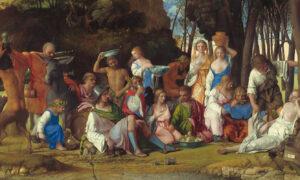There’s no painting more appropriate to pair with Thanksgiving than “Still Life With a Turkey Pie,” created by one of the most important 17th-century still-life painters, Pieter Claesz (1596/97–1660).
The works of Claesz epitomized the genre of still life, which not only featured a plethora of sumptuous banquet scenes of great aesthetic beauty but also reflected the cross-cultural trade and socioeconomics of the day.
During the early 1600s, still-life painting as a specific genre began to gain popularity in the Northern and Spanish Netherlands (present-day Netherlands and Belgium, respectively). Within this field there were specific subjects, such as florals, vanitas depictions, and food arrangements. The ascendancy of the “banket schilder,” or painter of banquet pieces, who specialized in the naturalistic depiction of luxury items, reflects the prosperous Dutch and Flemish society of the period.
Claesz’s Banquets
The Baroque artist Claesz was born near Antwerp in the Spanish Netherlands. Early in his career he moved north, as did many Flemish artists of the period, and settled permanently in the major Dutch city of Haarlem. The artist painted only still lifes and specialized in banquet (sometimes called breakfast) pieces and vanitas pictures. Claesz’s table scenes are meticulously composed. He often featured a range of familiar drinks and foods that may seem ordinary to the contemporary viewer but were costly luxuries in the 17th century. His innovative paintings are characterized by great attention to textures, carefully rendered perspective, illusionary lighting effects, and compelling compositions.
“Still Life With a Turkey Pie” is one of Claesz’s most ambitious works. This magnificent painting from 1627 is large—over four feet wide. With life-sized elements, the artist connects the painting’s space to that of the viewer. The table is well-appointed with luxurious objects: a porcelain bowl, nautilus shell, oriental chessboard carpet, damask cloth, and savory pies that contain exotic Asian spices such as cinnamon, cloves, ginger, and mace.
Analysis of the picture shows that it was painted from back to front, with objects in the foreground painted last. Claesz applied the paint smoothly, using broad brushstrokes for highlights and textural details.
The sumptuous display of food includes apples and two colors of grapes in a blue-and-white Wanli fruit bowl, which would have been imported from China. The grapes, along with the delicate vines that hover over them, are indicative of Bacchus, the Greek god of wine and vegetation. This allusion is amplified by the white wine in a “roemer” (a type of heavy wineglass often decorated at the stem with rounded beads known as prunts) and oysters, which were then believed to be aphrodisiacs. These foods, along with lemons, were delicacies in Claesz’s day and featured heavily as props in Dutch still lifes. The eponymous turkey pie in the painting is a beautifully articulated showstopper. The gullet and feathers of the fowl festoon the dish’s pastry crust, and its beak holds a floral stem.
Other objects in the painting showcase the artist’s ability in painting perspective, texture, and light. The engraved knife in the foreground points away from the viewer and casts a shadow on the tablecloth. The light shown to fall behind the table creates a further sense of depth. The pewter plates and flagon, likely to be silver, have a wonderful metallic tint. A reflection just visible in the body of the pitcher, which has a fantastic animal spout, faintly shows the artist at his easel.

The exquisite nautilus cup is composed of a shell set in a gilt mount. This support is decorated with blue enamel flowers. These cups were treasured objects in the Low Countries during the 17th century, combining natural wonders with artistic craftsmanship. The shell would have come from the waters of the Indo-Pacific region, arriving in Europe via a Dutch merchant vessel.
Though notations referring to Claesz’s paintings are often found when reviewing 17th-century estate inventories for prosperous Haarlem citizens, Claesz’s name was virtually unknown by the art world in the 18th and 19th centuries. It was not uncommon that over a lengthy period of time artist information was forgotten and lost, along with works being misattributed. Thankfully, in 1882, his “PC” monogram was identified with his artistic output. His work stands out still today, and his “Still Life With a Turkey Pie” gobbles up attention with its splendor.







